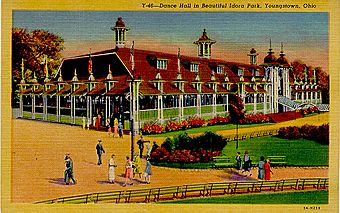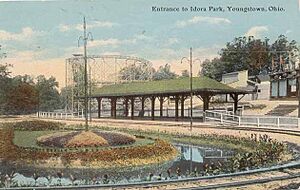Idora Park (Youngstown) facts for kids
- For another park of the same name in Oakland, California, see Idora Park.
Quick facts for kids |
|
|
Idora Park
|
|

The Dance Hall at Idora Park, c. 1935
|
|
| Location | Sw of the jct. of McFarland and Parkview Aves., Youngstown, Ohio |
|---|---|
| Architect | Harton, T.M., Co.; Philadelphia Toboggan Co. |
| Architectural style | Colonial Revival, Moderne, Italianate |
| NRHP reference No. | 93000895 |
| Added to NRHP | September 13, 1993 |
Idora Park was a popular amusement park in northeastern Ohio. It was open from 1899 to 1984. People often called it "Youngstown's Million Dollar Playground."
The Youngstown Park and Falls Street Railway Company built the park. It grew as the South Side of Youngstown expanded. Before it closed due to a big fire, Idora Park was one of the few city-based amusement parks left in the country.
How Idora Park Started
The park first opened on May 30, 1899, as Terminal Park. This was on Decoration Day, as it was known then. Many amusement parks, called trolley parks, were built at the end of trolley lines. This helped them make money on weekends.
There was no entry fee for the park. Anyone who could pay the trolley fare could come in. In its first year, the park had a bandstand, a theater, and a dance hall. It also featured a roller coaster, a circle swing, and food stands. Later, the park was renamed Idora Park.
A bridge over the Mahoning River opened in Youngstown on May 23, 1899. This helped the entire South Side area grow. The trolley line that went to Idora Park made it easy for people to visit.
Exciting Rides and Attractions
Roller Coasters: Wild Cat and Jack Rabbit
Idora Park had many fun rides. One of the most famous was the Wild Cat roller coaster. It was made of wood and opened in 1930. The ride was about 3,000 feet (914 meters) long and 85 feet (26 meters) tall.
The Wild Cat was a very modern ride for its time. It was designed by Herbert Paul Schmeck, who created many roller coaster ideas. In 1984, the Wild Cat was still thought to be one of the top ten roller coasters in the world.
Another popular ride was the Jack Rabbit. This wooden roller coaster was built in 1910. It was 70 feet (21 meters) tall and 2,200 feet (671 meters) long. The ride lasted about two and a half minutes. In the 1930s, it was made longer and changed a bit. To attract more visitors in 1984, the park turned the Jack Rabbit's trains around. They renamed it the Back Wabbit.
Kiddieland: Fun for Younger Kids
The Kiddieland area was once a huge concrete swimming pool. When the park was first built, it had this pool and a large bath house. A hole was drilled into the pool to connect it to an underground saltwater spring. This made it the only saltwater pool in the country.
In the 1950s, the park needed more space. So, the pool was replaced with a section for children's rides. The old bath house became a storage area.
Kiddieland had smaller, slower rides for kids. Some were like miniature versions of the park's bigger rides. For example, there was a small version of the Idora Special train. A small wooden roller coaster was also there for children.
This area also had a picnic spot where families could eat food they brought. There was an old-fashioned car path where kids could drive small cars. They had a track but allowed a little steering. Children's midway games were also available.
The Grand Ballroom
The Idora Park Ballroom opened on June 30, 1910. This open-air ballroom was inspired by one in Coney Island, New York. It was said to have the largest dance floor between New York City and Chicago. Later, the ballroom was enclosed so it could be used all year round.
Idora Park had its own band that played in the ballroom. But when radio became popular in the 1930s, the park started hiring famous bands. Over the years, the ballroom hosted many events. These included dances, concerts, New Year's parties, and even visits from politicians like John F. Kennedy.
Many famous musical acts played there, such as the Glenn Miller Orchestra, the Tommy Dorsey Orchestra, the Eagles, Ray Charles, Maynard Ferguson, Blue Öyster Cult, and The Monkees.
More Fun at Idora Park
Idora Park had many other attractions. These included:
- Kooky Castle, a haunted house.
- Laffin Lena's, a funhouse with a hall of mirrors.
- Old Saw Mill, a boat ride on water.
- Rides like the Tilt-O-Whirl, the Scrambler, the Caterpillar, and the Orbit.
- Bumper cars and a Ferris Wheel.
- A small passenger train called the Idora Express that went through the park.
- A spinning ride called The Rockets, with three large stainless steel rocket ships.
Near the rocket ride, there was a french fry stand. Their french fries were one of the most popular foods at Idora Park. The park also had midway games like a shooting gallery and a penny arcade. There was even a miniature golf course.
Why Idora Park Closed
Challenges and Decline
Idora Park did well for many years. However, it always faced competition from bigger amusement parks across the country. The park was only 27 acres (109,265 square meters) and could not expand. As cars became more common, trolley lines disappeared, and many trolley parks closed. Idora Park survived mainly because it was a popular place for picnics for different groups, churches, and companies.
A major event that hurt the park was the closure of Youngstown Sheet and Tube. This was a very large employer in the area. On September 19, 1977, they announced the closure of one of their biggest mills. This meant almost 5,000 jobs were lost overnight. This greatly affected Youngstown's economy and Idora Park.
Even during these tough times, Idora Park still had great rides. The Idora Park Merry-Go-Round was added to the National Register of Historic Places in 1975. In 1976, a book called Great American Amusement Parks named Idora Park one of the nation's 100 best. By 1980, the Wild Cat and Jack Rabbit roller coasters were recognized as some of the best in the country.
However, by the early 1980s, the park felt old. It even had rides from other parks that had closed down.
The Devastating 1984 Fire
A terrible fire happened on April 26, 1984. It destroyed the Wild Cat roller coaster, the Lost River ride, and eleven food stands. The park office was also burned. Employees tried to save park records, but only the most recent files were rescued. Older records and historical documents were lost. Workers tried to put out the fire with small extinguishers, but it quickly grew out of control.
Twelve fire departments came to help. The fire spread fast because winds carried it across the food stands and onto the midway. Flames also spread along the Wild Cat's wooden tracks. They threatened the merry-go-round, which was burned but saved. Firefighters had trouble because there were not enough hydrants in the park. Water pressure was low, and the old wooden rides and buildings burned easily. They finally controlled the fire by connecting hoses to hydrants outside the park.
The damage was estimated to be millions of dollars. The intense heat melted paint in some areas. The south part of the Wild Cat roller coaster was destroyed. The cost to repair it was too high.
The park stayed open through the summer of 1984. But with its main ride gone, the owners decided to close it for good. Idora Park welcomed its last visitors on September 16, 1984.
On October 20–21, 1984, an auction was held. The park sold its rides and equipment. The remaining roller coasters, like the Wild Cat, Jack Rabbit, and Baby Wild Cat, were left behind. Many buildings, including the Ballroom and the French Fry stand, were also abandoned.
New Owners and What Happened Next
In 1985, Mt. Calvary Pentecostal Church bought the Idora property. They planned to build a religious center called the "City of God." The Ballroom stayed open for events until May 1986. But the church lost the property in 1989 because they owed more than $500,000.
The Park Falls Apart
In an interview in 1984, the former owner of Idora Park, Max Rindin, was asked what would happen to the park. He said, "In time, it’ll all be torched." Sadly, his words came true. Another fire happened on May 3, 1986. It destroyed the Heidelberg Gardens, Kooky Castle (the haunted house), Laffin Lena's (the fun house), and the bumper car buildings.
Over time, Mt. Calvary Church did not build their religious center. The property fell apart. It was not kept safe from people who trespassed. The remaining buildings at Idora Park were vandalized. They were also destroyed by weather or by more fires.
Efforts to Save Parts of the Park
By 1999, a group tried to buy the Jack Rabbit or Wild Cat roller coasters. They wanted to fix them up at another park. They also planned to buy the merry-go-round. But these plans never happened. The ballroom, Jack Rabbit, and Wild Cat were left to decay.
The 2001 Fire and Demolition
On March 5, 2001, the Idora Park Ballroom burned down. The fire seemed suspicious and started in the basement. The Jack Rabbit and other wooden structures were not destroyed by this fire. After the fire, the property owners said they would let preservation groups take down the roller coasters if they paid for it.
However, on July 26, 2001, the Wild Cat, Jack Rabbit, and all other old structures were torn down by bulldozers. City officials asked for them to be removed because they were dangerous. Both the Jack Rabbit and Wild Cat were on a list of roller coasters to be saved. But the owners did not act to save them, leading to their destruction.
The church said they still planned to build the "City of God" project. But as of 2013, they had not started building.
What Might Happen to the Land Now
The property still belongs to Mt. Calvary Pentecostal Church, but there are no buildings on the land. The "City of God" project was never built. The church faced financial problems and filed for bankruptcy in 2017.
The city of Youngstown has also shown interest in getting the property. They want to turn it into a green space next to Mill Creek Park. These plans are on hold until the city can get the property from the church.
In April 2014, Jim and Toni Amey opened a museum called The Idora Park Experience. It is next to their house in Canfield, Ohio. They own many items from Idora Park and show them at the museum. The museum opens a couple of times a year and sells items related to the park. The Ameys even tried to buy the property from the church, but the church refused to sell it.
The Carousel's Better Fate
The Idora Park Merry-Go-Round was saved and moved. It is now known as Jane's Carousel and is located in Brooklyn, New York.
- Guerrieri, Vince. "Youngstown's Million Dollar Playground", The New Colonist, September 10, 2004.
- Shale, Rick. "Idora Park: Last Ride of the Summer", Amusement Park Journal, May 1999.
- Amey, James M. and Toni L. "Lost Idora Park", (Images of America), Arcadia, August 2019.
Images for kids





